Introduction and Package

Another day goes by and we take the time to test out another motherboard based on the latest Z87 chipset form Intel. Today we're looking at an offering from MSI which is under the newer MPOWER name. This isn't the first time we've seen MSI use this name, as late last year we saw the company release the MSI Z77 MPOWER.
The new series brought with it a strong performing motherboard, along with a new look for the company. Impressed with what it was offering, we're looking forward to see what MSI has done with the name on the latest generation Intel chipset. Recently we've seen the company really try to show us something a little different and almost try to rebrand itself.
The new Gaming series brings a feeling of unity between the video card and motherboard segments of MSI as products under both categories are part of the one series. The MPOWER name helps differentiate itself by letting us know that they sit at the top of the pyramid for MSI. We'd really like to see the company bring something like the "Lightning" series of video cards under the same MPOWER name and really create some synergy between both product categories.
The new "POWER" series of boards from MSI currently consists of three Z87 based models. We've got the Z87 XPOWER, along with the Z87 MPOWER and MPOWER MAX, with us today looking at the latter.
Package


As we flip over the "M" you can see we get some information on the actual motherboard including the Military Class 4 components, which include Hi-c CAP, Dark CAP, SFC and OC PCB. Some of the other major highlights included Enhanced Power including a Dual 8-pin CPU Power Connectors, Enhanced Thermal via a new heatsink designed, Enhanced BIOS including Click BIOS 4 and OC Essentials which include Direct OC, Easy Button 3 and V-Check Points to name just a few of the features. We'll be checking some of these out a little more when we move onto the board itself.


As we move onto the other side you can see we get our first look at the board. With only part of it being seen via the "M" cut out, though, we don't get the best look. Turning over to the back you can see we've got the main specifications at the bottom, a number of logos in regards to the features that are offered and again some of the main features are highlighted in the overclocking ability, stability and enhanced PWM cooling.

Moving inside the box you can see we've got an absolute ton of paperwork covering many aspects of the board. You can also see we've got a couple of discs including drivers and utilities and one of the new "G" Series case stickers.

Moving into the cable side of things you can see we've got six SATA cables along with an eSATA cable and a power cable. Across the bottom you can see the rear I/O panel and a single SLI bridge.

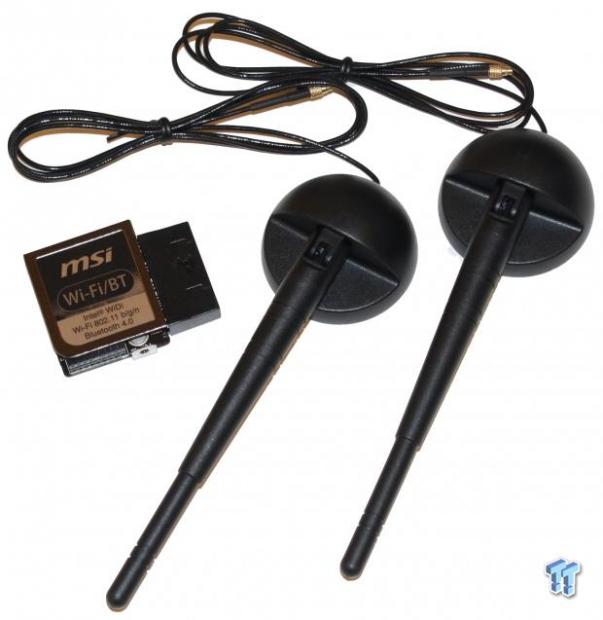

Other extras include a pair of USB 3.0 and eSATA headers, Wi-Fi / BT card along with two antennas, V-Check point cables and a pair of EZ-Connectors to make hooking up everything that little bit easier. The bundle from the MSI MPOWER MAX really is quite large and one of the largest we've seen so far when it comes to the new Z87 platform.
MSI MPOWER MAX Motherboard
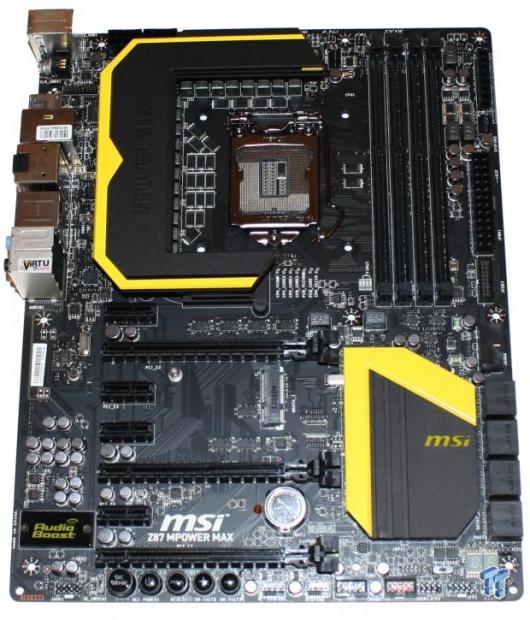
Getting onto the motherboard you can see we've got the same black and yellow color scheme that was used on the previous MPOWER board. Overall it looks fairly standard from here so let's move in a bit closer and see just what exactly we're dealing with.
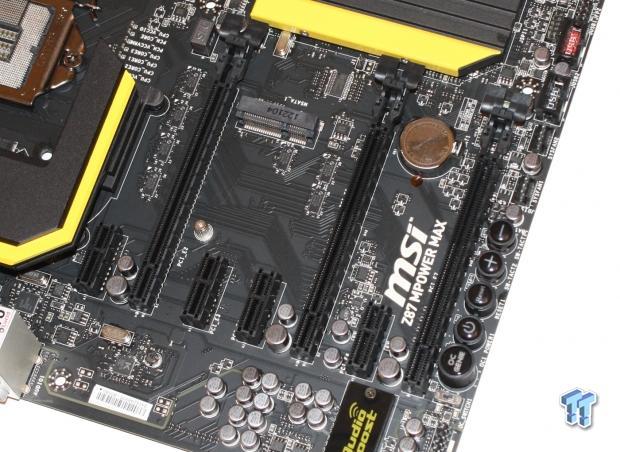
Moving over to the PCIe expansion side of things you can see we've got four PCIe x1 slots and three PCIe x16 slots. If you're using just one card, the top slot will run at x16, if you're using two both will run at x8. If all three are used, the top two will be x8, while the bottom will operate at x4. Also you can see between the top two PCIe x16 slots we've got an mSATA port.

Heading to the bottom of the board you can see we've got the normal connectors including USB 2.0, fan headers, front I/O header and on the far right you can see the debug LED reader. Across the bottom you can also see we've got a number of buttons including the OC GENIE button, power and reset along with direct OC buttons giving you the ability to overclock while the system is on.
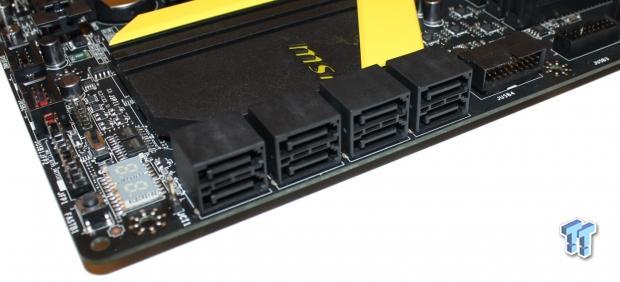
Turning the corner you can see we've got a total of eight SATA III ports. Six of those run off the Intel Z87 controller, while the other two run of the ASMedia ASM1061 controller. You can also see towards the top we've got a USB 3.0 header.

Heading over to the top of the board you can see four DIMM slots supporting up to 32GB of DDR3 memory ranging from 1066MHz DDR to 3000MHz DDR via overclocking. Towards the top right of the board you can see the V-Check points that allow us to check the voltage points of a number of areas on the board. Moving down you can see the main 24-pin ATX power connector.


Heading around to the CPU area you can see we've got two 8-pin CPU connectors for people who require more power. Unless you're doing some serious overclocking with LN2, though, you'll more than likely find yourself just using one.

Heading into the I/O side of things you can see from the left we've got a pair of USB 2.0 connectors and a combo PS/2 port. Next to that we've got a clear CMOS button and a total of six USB 3.0 ports. Gigabit networking is provided by the Killer E2205 Gigabit LAN controller and video out options include dual HDMI and a single DisplayPort connector. We've also got an optical out port along with six Auxiliary ports which run off the ALC1150 codec.
BIOS

Heading into the BIOS we're dealing with the new CLICK BIOS 4. From first glance the overall layout is pretty similar to what we've seen in the past, but a bit like the new Gaming Series board we looked at recently, you can see the BIOS is color coded to match the board / series that it's on. There's also a few subtle additions that we'll look at in just a moment.
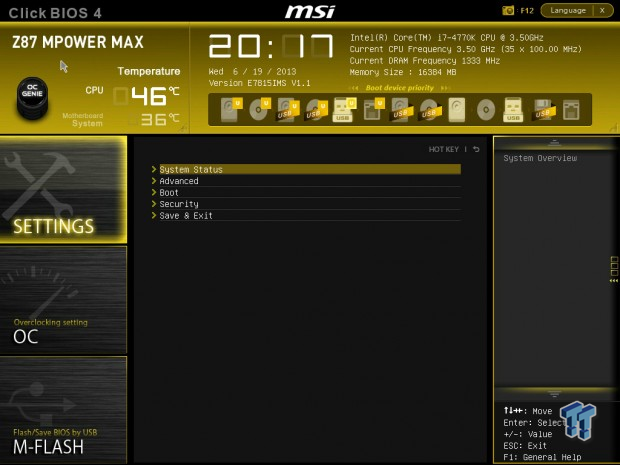


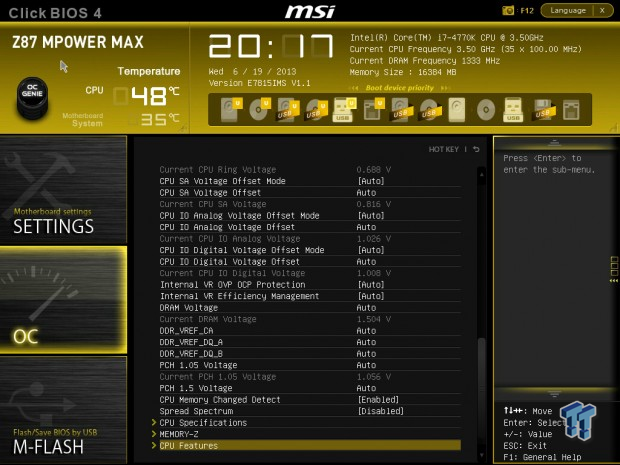


All the standard options are here and if you're in the BIOS, you'll probably no doubt be heading into the OC section of the BIOS, which of course gives us all the overclocking options that we're used to seeing.



Two new areas that stand out, though, include the new Hardware Monitor section that gives us a more detail look at what's going on in a number of areas. It's pretty nice and a good overall addition to the BIOS. The other area is the new board explorer section that tells us what is where. As you can see in the second picture our mouse cursor is over the CPU area and you can see across the bottom that it lets us know we're using an i7-4770K which is clocked at 3.5GHz.
Benchmarks - Test System Setup and Overclocking

We would like to thank the following companies for supplying and supporting us with our test system hardware and equipment: Intel, ASUS, MSI, Western Digital, MemoRight and Corsair.
As we test more and more Z87 boards we're able to expand the amount of them we include in our graphs. Today, alongside the MSI MPOWER MAX, we've got the ASUS Z87-Expert and ASRock Z87 OC FORMULA. Along with those boards we've also got the ASUS P8Z77-V Pro/Thunder bolt and MSI Z77A-GD65 Gaming from the Z77 side of things, along with the GIGABYTE X79S-UP5-Wi-Fi.
As always, before we get into the performance side of things, we need to look at overclocking. With everything running fine at stock, we headed into the BIOS to see just what we could do. It was all a pretty standard affair when it came to the overclocking side of things and we really found our max overclock quite quickly.

We messed around with the multiplier and voltages a little and in the end we had our CPU running at 4.7GHz via a 47x Multiplier and a 100 BCLK. This is a pretty strong overclock and seems to be about the best this particular CPU we're using is capable of doing.
CPU Benchmarks
HyperPi 0.99
Version and / or Patch Used: 0.99
Developer Homepage: www.virgilioborges.com.br
Product Homepage: www.virgilioborges.com.br
HyperPi is a front end for SuperPi that allows for multiple concurrent instances of SuperPi to be run on each core recognized by the system. It is very dependent on CPU to memory to HDD speed. The faster these components, the faster it is able to figure out the number Pi to the selected length.
For our testing we use the 32M run. This means that each of the four physical and four logical cores for the i7 and the four physical cores of the i5 is trying to calculate the number Pi out to 32 million decimal places. Each "run" is a comparative to ensure accuracy and any stability or performance issues in the loop mentioned above will cause errors in calculation.

AIDA64
Version and / or Patch Used: 1.00.1035BETA
Developer Homepage: http://www.aida64.com
Product Homepage: http://www.AIDA64.com
Replacing Everest in our labs is AIDA64. This new testing suite is from the core development team from Lavalys and continues that tradition. The guys have thrown in better support for multithreaded CPUs as well as full 64 bit support. We use this to test memory and HDDs for now, but may find ourselves opening this up to other areas of the motherboard.
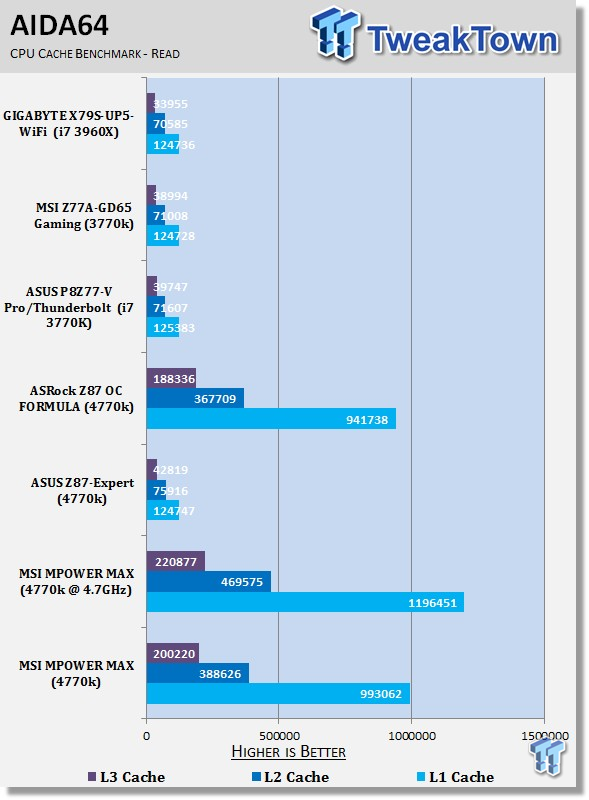

Hyper Pi performance out of the box lines up with the ASRock Z87 OC FORMULA. Looking at AIDA64 CPU performance, though, you can see that out of the box the MSI Z87 MPOWER MAX is actually sitting slightly ahead of the competition.
Overclocking as you'd always expect helps boost performance even further, and coming in at 4.7GHz as well means we get quite a nice jump.
System Benchmarks
PCMark 7
Version and / or Patch Used: 1.04
Developer Homepage: http://www.pcmark.com
Product Homepage: http://www.pcmark.com
PCMark 7 includes a range of tests that give different views of your system's performance. In the Advanced Edition you can choose which tests to run. The common use and hardware component tests are unavailable in the Basic Edition.
Overall system performance is measured by the PCMark test. This is the only test that returns an official PCMark score. The Lightweight test measures the system capabilities of entry-level systems and mobility platforms unable to run the PCMark test, but it does not generate a PCMark score. Common use performance is measured by the scenario tests - Entertainment, Creativity and Production - each of which results in a scenario score. Hardware component performance is measured by the hardware tests - Computation and Storage - each of which results in a hardware score.

MediaEspresso
Version and / or Patch Used: 6.5
Developer Homepage: http://www.cyberlink.com/
Product Homepage: http://www.cyberlink.com/products/mediaespresso/overview_en_AU.html?fileName=overview&r=1
MediaEspresso is a blazingly fast media universal converter that can transcode your videos, photos and music files and out put them to a huge range of portable devices including mobile phones, portable media players and even game consoles. With technologies like Smart Detect, Direct Sync and CyberLink's TrueTheater™ video enhancements, you can not only forget about complicated format, resolution and output settings, but your converted file will come out the other side looking better than when it went in!

We again see that the MSI Z87 MPOWER MAX comes out ahead of the competition at stock. You can see under both PCMark 7 and MediaEspresso it has a nice little lead.
USB 2.0 and 3.0 Benchmarks
AIDA64
Version and / or Patch Used: 1.70.1400
Developer Homepage: http://www.aida64.com
Product Homepage: http://www.AIDA64.com
Replacing Everest in our labs is AIDA64. This new testing suite is from the core development team from Lavalys and continues that tradition. The guys have thrown in better support for multithreaded CPUs as well as full 64 bit support. We use this to test memory and HDDs for now, but may find ourselves opening this up to other areas of the motherboard.

USB 2.0 and USB 3.0 performance holds no surprises as you can see the MSI board lines up with the other options here.
SSD Benchmarks
AIDA64
Version and / or Patch Used: 1.70.1400
Developer Homepage: http://www.aida64.com
Product Homepage: http://www.AIDA64.com
Replacing Everest in our labs is AIDA64. This new testing suite is from the core development team from Lavalys and continues that tradition. The guys have thrown in better support for multithreaded CPUs as well as full 64 bit support. We use this to test memory and HDDs for now, but may find ourselves opening this up to other areas of the motherboard.

HD Tune Pro
Version and / or Patch Used: 4.61
Developer Homepage: http://www.hdtune.com
Product Homepage: http://www.hdtune.com
HD Tune Pro gives us accurate read, write and access time results and for the last couple of years has been gaining popularity amongst reviewers. It is now considered a must have application for storage device testing.

Looking at the performance of our SSD you can see under AIDA64 it lines up with the other Z87 options, with little separating all three boards. Like the ASRock offering, though, you can see when we move to HD Tune Pro, performance does drop back. This seems to be fairly consistent under HD Tune Pro on the new Z87 chipset.
mSATA Benchmarks
HD Tune Pro
Version and / or Patch Used: 4.61
Developer Homepage: http://www.hdtune.com
Product Homepage: http://www.hdtune.com
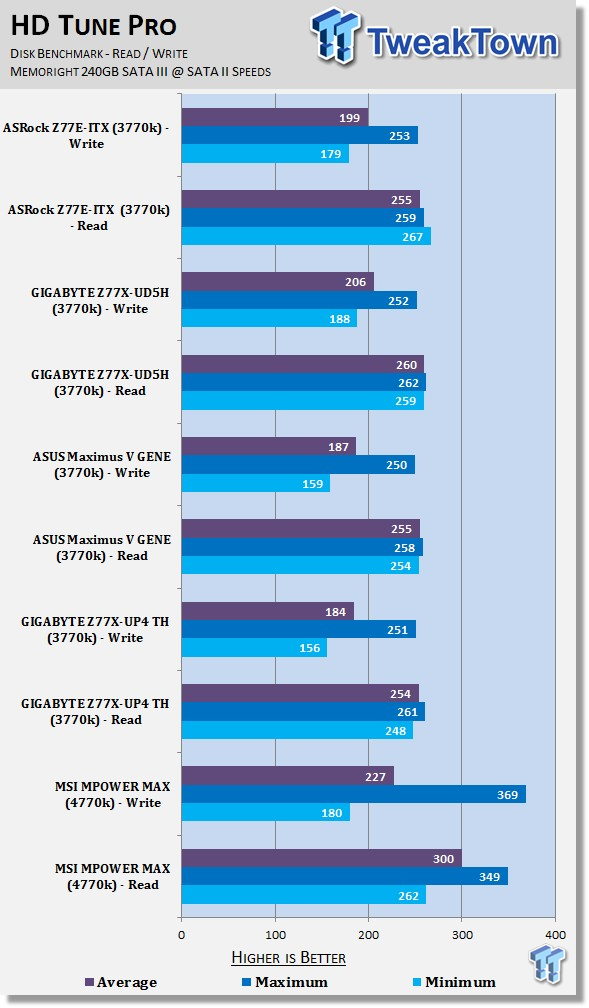
This is the first time we've had a chance to look at mSATA performance on the new Z87 platform and you can see across the board we're ahead compared to the previous generation Z77 boards.
Write and read performance is 50 - 100MB/s up depending on the area.
Memory Benchmarks
AIDA64
Version and / or Patch Used: 1.00.1035BETA
Developer Homepage: http://www.aida64.com
Product Homepage: http://www.AIDA64.com
Replacing Everest in our labs is AIDA64. This new testing suite is from the core development team from Lavalys and continues that tradition. The guys have thrown in better support for multithreaded CPUs as well as full 64 bit support. We use this to test memory and HDDs for now, but may find ourselves opening this up to other areas of the motherboard.

Memory performance between the ASRock and MSI board are pretty similar at stock. We can't really compare to the ASUS due to the fact that the latest AIDA64 version seemed to boost numbers slightly on the new platform.
Overclocking as we've seen all along does little to memory performance. This has become extremely consistent in all our Z87 testing thus far.
Gaming Benchmarks
3DMark 11
Version and / or Patch Used: 1.0
Developer Homepage: http://www.futuremark.com
Product Homepage: http://www.3dmark.com/3dmark11/
3DMark 11 is the latest version of the world's most popular benchmark. Designed to measure your PC's gaming performance 3DMark 11 makes extensive use of all the new features in DirectX 11 including tessellation, compute shaders and multi-threading. Trusted by gamers worldwide to give accurate and unbiased results, 3DMark 11 is the best way to consistently and reliably test DirectX 11 under game-like loads.

Metro 2033
Version and / or Patch Used: Latest Steam Update
Timedemo or Level Used: Built in Benchmark
Developer Homepage: http://www.4a-games.com//
Product Homepage: http://www.thqnordic.com/
Metro 2033 is an action-oriented video game with a combination of survival horror and first-person shooter elements. The game is based on the novel Metro 2033 by Russian author Dmitry Glukhovsky. It was developed by 4A Games in Ukraine and released in March 2010 for Microsoft Windows and Xbox 360.[3] In March 2006, 4A Games announced a partnership with Glukhovsky to collaborate on the game.[4] The game was announced at the 2009 Games Convention in Leipzig;[5] a first trailer came along with the announcement.[6] A sequel was announced, currently titled Metro: Last Light.

Checking out the gaming performance the numbers are just as you'd expect. Apart from a slight boost in the lower resolution testing when overclocking, you can see the numbers across the board are similar on all platforms.
Temperature and Power
Power Consumption

Looking at the power numbers you can see at stock the MSI MPOWER MAX lines up with the other boards when it comes to idle. Looking at the load numbers, you can see it sits a little higher, like the ASRock offering. Overclocked sees a jump in both areas as you'd expect, but not by much.
Core Temperature

Out of the box the idle temp on the MSI offering is good. As for the load temperature, you can see it sits in the mid-60c range, like the ASUS offering. Overclocking brings a slight bump to our idle temp and the load temperature moves up to the 90c mark.
Pricing, Availability and Final Thoughts
Coming in at $259.99 at the time of writing, the MSI MPOWER MAX is cheaper than you'd actually think. Considering the features that are offered on the board, along with the out of the box performance, we really thought that it would cost a little more, like around the $279 - $289 mark.
MSI have really done a good job of ticking all the right boxes here. The package includes a ton of extras including a Wi-Fi and Bluetooth receiver, along with the eSATA and USB 3.0 headers. Again considering the price point of the board, this is a really nice bundle that has been put together by MSI.
The performance, though, is probably the one area that really stands out. Out of the box we saw the MSI board perform extremely well in many areas with it often coming out ahead of both the ASRock and ASUS offerings. Overclocking performance was also strong and lined up with the ASRock board at 4.7GHz. As we mentioned when we spoke about overclocking earlier, this seems to be the limitation of our particular i7 4770k CPU.
Finally the last area that has to be covered is the features. Again this is an area MSI has done a really good job in. The board looks great and the new Military Class 4 components clearly do an excellent job of helping create a board that is fast and stable. Along with all that the addition of the Killer Networking adapter is always nice. The latest Click BIOS 4 also looks good, and as you can see on the BIOS page, we've got a few added areas that offer us some more information and a new look.
All in all MSI has put together a really strong Z87 motherboard here and we're looking forward to seeing more of the "POWER" boards from them in the future. If this new MAX version is anything to go by, they should be able to offer some strong competition in the highly competitive market against the likes of GIGABYTE, ASUS and ASRock.

